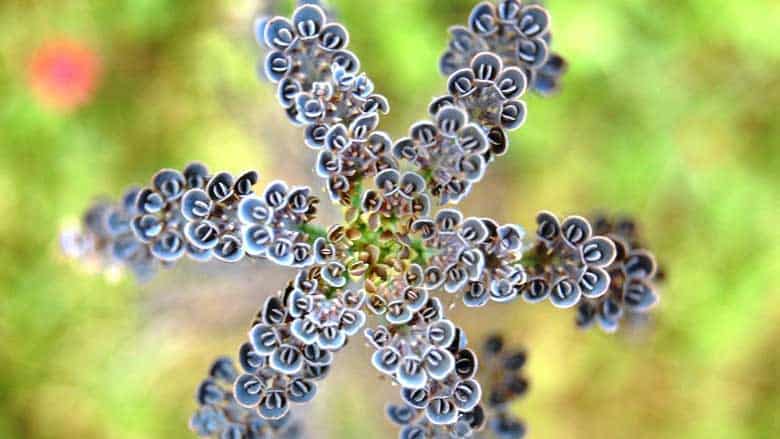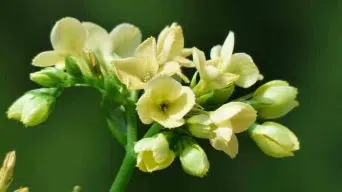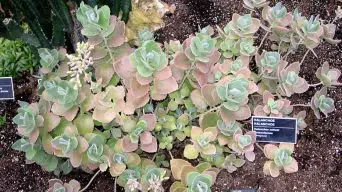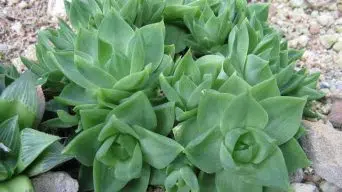The Kalanchoe tubiflora is a succulent plant originally from Madagascar, but it has now become popular worldwide.
It’s not hard to see why this plant would be so popular – it has beautiful flowers and gorgeous leaves, making for incredible decorations in the home or office!
In this guide, we will discuss how to care for your Kalanchoe tubiflora and how to propagate them if you want more plants of your own.
Overview
The Kalanchoe tubiflora, also known as the “Mother of Millions” or “Chandelier Plant,” is a native to Madagascar.
This plant gets its name from the distinctive appearance of its leaves, which have long edges with “teeth” and tiny plantlets running along with them.
The Kalanchoe tubiflora succulent plant has flowers that grow in clusters at the top of the plant and tubular flowers with individual stalks.
These flowering succulents have blooms that are pale pink to bright reddish-orange.
Some other names that are often used as synonymous for this Kalanchoe species are:
- Kalanchoe delagoensis
- Bryophyllum tubiflorum
- Bryophyllum verticillatum
- Bryophyllum delagoense
- Geaya purpurea
How To Care for Kalanchoe Tubiflora (Mother of Millions)
A Kalanchoe tubiflora is a fascinating succulent plant.
They are popular because of their variety and unique appearance. Still, they need special care to thrive indoors or outdoors in the garden.
Below we will go over how you can take good care of your Kalanchoe so it thrives for years!
Sun Exposure & Light Requirements
Kalanchoe tubiflora is an indoor-outdoor succulent and will need to be taken in during the cold months.
Placing this Chandelier plant in a location where it gets bright indirect sunlight–such as near a window that faces west or south, but not north–is ideal for its growth.
If you cannot provide enough light indoors, then place your Kalanchoe Tubiflora at least six feet from windows with southern exposure so they can absorb some sun without being too hot.
When grown outdoors, make sure there’s plenty of shade because too much direct sunlight will burn them up!
Watering Requirements
The Kalanchoe tubiflora succulent plant is an extremely hardy, low-maintenance houseplant that can tolerate drought, neglect, and abuse.
Unlike most plants, the Kalanchoe tubiflora does not require regular watering.
However, if you regularly water your Kalanchoe with good drainage, then once or twice per week should be enough water.
In addition to watering, the leaves of this slow-growing succulent may develop brown tips from overwatering, which means too much moisture in the air pockets under its leaves.
Unlike other plants, overwatered Kalanchoes do not recover well and typically only last one more year before dying off altogether.
Soil Requirements
The Kalanchoe tubiflora succulent requires a very well-drained soil.
Because of the low water retention capacity, it is essential to ensure that the plant doesn’t stay in soggy soil for too long or root rot.
We recommend adding grit and perlite as these materials hold moisture and provide drainage properties.
The potting mix should drain quickly but retain enough moisture so that leaves don’t wrinkle up from lack of hydration during colder months.
The best soil mix for this succulent is a cactus mix, which has the needed drainage and water retention properties.
Temperature and Humidity
Temperature and humidity levels are essential to successfully growing Kalanchoe tubiflora.
These plants require a temperature range of 60-70 degrees Fahrenheit, with an optimal level at 65 degrees Fahrenheit.
Temperatures outside this range will cause the succulent leaves to droop or become soft and floppy.
The ideal relative humidity is between 45% and 50%. If it drops below 40%, you should consider using a humidifier in your Kalanchoe’s room.
Fertilizing
Kalanchoe tubiflora plants don’t like too much fertilizer, but, sometimes used in moderation, it helps improve their health and growth.
Use fertilizers that are specifically for succulents or cacti, which have been made to be slow-release, so they don’t burn the plants with nutrients.
A diluted liquid fertilizer solution can be applied every two to three weeks or monthly with weaker solutions during the growing season.
When plants are not growing in the winter months, fertilizing is only needed once per month.
Potting and Repotting
Kalanchoe tubiflora plants enjoy being potted in well-draining potting soil that is moist but not wet. When the plant becomes root bound or too big, it may be time to repot your Kalanchoe. Be careful when you choose a new pot for transplanting.
The Kalanchoe tubiflora will thrive when it has plenty of room for root growth. So make sure you choose a large enough planter or transplant it into larger containers to allow ample space for these succulent plants as they grow taller over time.
- To transplant your Kalanchoes:
- Lifting the plant out of its current pot
- Loosen up any remaining roots and remove them gently from the old soil
- Place in a new container filled with moistened potting mix or well-drained garden soil
- Place the plant in an area with bright, indirect light or full sun
- Newly planted Kalanchoes do not need much water early on but will eventually require watering about once every week.
Some things to consider when transplanting are:
- Kalanchoe tubiflora plants prefer to be planted in pots that have drainage holes. So it is important not to pour potting soil over the top of them when planting.
- When you transplant kalanchoes into a pot or container with no drainage hole, ensure plenty of pebbles are at the bottom for proper draining before adding any dirt. Kalanchoes do not like standing water around their roots.
- It might take some time for your newly potted plant to adjust from one size container to another.
- If, after two weeks, all leaves begin turning yellow, then this could mean that they were not given enough space in their new home. In this case, it’s best to transplant them back into a container with more room for root growth.
- Kalanchoes are not typically planted in the ground. Still, they can be if you live somewhere that doesn’t experience frost or freezing temperatures.
Pruning
You can prune Kalanchoe tubiflora a few times per year.
However, when you’re pruning Kalanchoe tubiflora succulents, the best time is right after they are done blooming.
Removing any stems that are crossing or in odd spaces is best, as this will help the shape of your Kalanchoe.
You’ll also want to cut off lower leaves that are wilted and older than three years old – these won’t stay fresh for long periods either.
In addition, you should pinch back tips on new growths if they tend to grow in a different direction than desired.
Pests and Diseases
One of the problems with Kalanchoe tubiflora plants is that they are susceptible to a variety of pests and diseases.
Diseases
One common problem is rot and gray mold during wet weather because their leaves tend to retain water for too long.
Several types of fungus infections will cause dry brown patches on the plant’s foliage or stems.
Pests
The most dangerous type of infestation involves insects that can spread viruses.
Aphids are the most common; they can carry a mosaic virus and transfer it to other plants through their mouthparts, honeydew secretions, and leg contact.
Aphid damage often occurs in clusters where large numbers feed together at once; this limits airflow between succulent clumps making them more vulnerable to infection.
Thrips are another common pest. They feed on the plant’s juices and cause leaf distortion, brown or bronze patches, and decreased flower production.
Most thrip problems occur during cool weather when they overwinter in garden debris such as fallen leaves.
The most important pests to watch for are scale insects.
Scale insects suck sap from the leaves and roots of plants. This makes the plant to be very small, turn yellow, or have wilted leaves and flowers.
How to Care for Kalanchoe Tubiflora in Winter
Kalanchoe tubiflora care in the wintertime is mostly about reducing the risk of frost damage.
Kalanchoes are not frost-tolerant plants like most desert cacti or tropical palms; they need protection from cold weather at all times!
To reduce this risk, you should choose a frost-free location.
If your kalanchoe tubiflora is outside and there’s no danger of winter cold, or it can’t be moved indoors before the first freeze arrives, cover it with an insulating material like straw or leaves.
If you have any doubts about how well your Kalanchoe plant will survive outdoors in the winter, bring your succulent inside!
When your Kalanchoe plants are already indoors and your home’s temperature is below 60 degrees, place them in a cool area with bright light.
Don’t move them into an excessively warm room or keep them close to heating vents. This will cause excessive leaf loss and burn the leaves’ surface if temperatures fluctuate.
How To Propagate Kalanchoe Tubiflora
The Kalanchoe tubiflora propagation is very easy.
They are propagated through the tiny buds that grow off the edges of the leaves. These little plantlets are called the Kalanchoe Tubiflora Offsets.
Eventually, these small plantlets fall off and root themselves where they contact the ground.
The offsets will grow better when planted in a pot of soil mixed with sand, perlite, or other adding materials to improve drainage and water retention.
The best time to plant is during late winter or early spring before temperatures rise above 65 degrees Fahrenheit (18° C).
Choose a pot that only has enough space for two plants because it’s possible for them to be overcrowded if there is not ample room between each offset.
It is important to note that Kalanchoe tubiflora propagation requires a little time because it’s necessary for them to grow their roots before they can be transplanted.
They will need about six weeks to do this, so if you plan on planting outside, make sure that it’s done at least six weeks prior and then wait until all danger of frost has passed.
Is the Kalanchoe Tubiflora Toxic?
According to the ASPCA, the Kalanchoe tubiflora plant is toxic to dogs, cats, and horses.
The Kalanchoe tubiflora contains Bufadienolide compounds that are poisonous to cats and dogs. Signs of poisoning include vomiting, diarrhea, increased salivation, ataxia (unsteady gait), dilated pupils, and a lowered heart rate.
The Kalanchoe tubiflora is also toxic to humans if ingested in large quantities or after prolonged exposure: it can lead to nausea, headache, weakness, and loss of appetite.
Do not handle the plant with bare hands because some people may experience skin irritation from handling them without gloves.
Wearing gardening gloves should prevent this problem for most individuals who plan on touching it often during their garden care routine.
Final Thoughts
The Kalanchoe tubiflora plant is an excellent addition to any home or office.
The Chandelier plant care is relatively easy, and the plant propagates quickly. It can be used as a ground cover or an indoor potted plant.
With a bit of care and attention, this plant will last for many years in your home.







